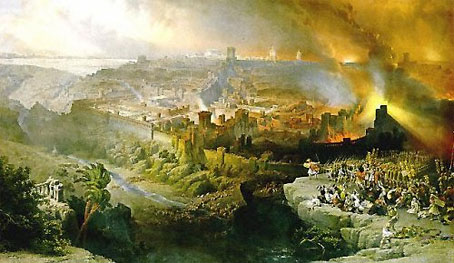Apr
8
2009
“As you saw iron mixed with ceramic clay, they will mingle (intermarry) with the seed of men; but they will not adhere to one another, just as iron does not mix with clay.” Dan 2:43
I think the key to Genesis 6 is that this pattern is repeated many times in the Bible. It was the sin of INTERMARRIAGE, of compromise between the priesthood and unbelieving women. Adultery and idolatry have a close connection. Continue reading
Comments Off | tags: Babylon, Compromise, Genesis, Herod, Temple, The flood | posted in Biblical Theology, The Last Days
Apr
8
2009
“…when one is confronted with the language of Revelation it is no mere difference of style which makes one gasp, but crudities, grammatical errors and a quite extraordinary juxtaposition of words. So wholly different is the book in its word-usage and composition from the Fourth Gospel that many scholars find themselves unable to believe that both could be written by the same person. The Fourth Gospel is written, within its limited vocabulary, smoothly and correctly and would probably have caused no literary qualms in a contemporary Greek reader. But Revelation piles word upon word remorselessly, mixes cases and tenses without apparent scruple, and shows at times a complete disregard for normal syntax and grammar… Continue reading
Comments Off | tags: Apocalyptic, John, Revelation | posted in The Last Days
Apr
8
2009
 An examination of the teachings of Jesus on eschatological issues. Also, a look at the dating and interpretation of the Book of Revelation.
An examination of the teachings of Jesus on eschatological issues. Also, a look at the dating and interpretation of the Book of Revelation.
by W.A. Young, Jr. Th.D. Covenant Theological Seminary www.trinityreformed.com
Nothing is more interesting than the study of what is referred to as the end-times. Nothing sells books, tapes, or videos like future prophecy. Preoccupation with the future is what sells horoscopes, palm readings, and the like. We all face the fears and hopes of what the future may bring. People want to know what will happen in the end.
The purpose of this paper is to review the nature of eschatology. There has been a major shift in eschatological perspective that has swept through much of evangelicalism today. This has occurred in the last one hundred to one hundred and fifty years. It has both violated and permeated much of the church’s teachings concerning the end of this age.
My own journey, especially during the early formative years, was one of vacillation. In the early days, I subscribed to the majority report among evangelicals, the dispensational view. This view is characterized by Hal Lindsey and others. Dispensationalism came about in the 1830′s and is built on the futurist system and supported by the Scofield Bible. It dominates evangelical preaching, education, publishing, and broadcasting today. I suspect the reason is that Scofield presents such a systematic approach that an individual can easily subscribe because it is so easily laid out in his footnotes. As I have grown in my understanding of scriptures I have come to see that the moderate Preterist perspective best presents the biblical perspective. This view is what is under consideration in this paper. Continue reading
Comments Off | tags: David Chilton, Eschatology, Kenneth Gentry, Preterism, Revelation, Scofield Bible, Temple | posted in The Last Days
Apr
8
2009
In the Sermon on the Mount, Jesus gave the pattern for a new Tabernacle. The sermon follows the pattern of the Tabernacle furniture, which in turn follows the pattern of the Creation week.1 At ‘Day 3′, Altar and Table, are His commands concerning Covenants (divorce and oaths), and the Lord’s prayer.
“Leave your gift there before the altar, and go your way. First be reconciled to your brother, and then come and offer your gift.” Matthew 5:24
Interestingly, these blessings are mirrored by the curses upon the saints’ evil twins in Matthew 23, the Jews who sat in Moses’ seat of judgment.2 The “woes” follow exactly the same pattern, and climax with Christ’s prophecy of the destruction of the Old Covenant Temple. And what do we find in this passage at Day 3?
Continue reading
Comments Off | tags: Altar of the Abyss, Daniel, Gehenna, Passover, Sermon on the Mount, Table of Showbread, Temple, The flood | posted in Biblical Theology, The Last Days
Apr
8
2009
And the fifth angel blew his trumpet, and I saw a star fallen from heaven to earth, and he was given the key to the shaft of the Abyss. He opened the shaft of the Abyss, and from the shaft rose smoke like the smoke of a great furnace, and the sun and the air were darkened with the smoke from the shaft. Revelation 9:1-2
The fifth trumpet aligns with both the Feast of Trumpets, and Deuteronomy. It is the summoning of armies on Day 5, swarms of birds and fish filling sky and sea as glorious clouds. The Altar of the Abyss, in this case, is now an evil twin of the Altar of Incense, a demonic response to the ascension of Christ and His new government. Continue reading
Comments Off | tags: Altar of the Abyss, Babylon, Elijah, Incense Altar, Judaisers, Revelation, Satan, Sodom | posted in Biblical Theology, The Last Days
Apr
8
2009
“And another angel came out from the altar, the angel who has authority over the fire, and he called with a loud voice to the one who had the sharp sickle, “Put in your sickle and gather the clusters from the vine of the Land, for its grapes are ripe.” So the angel swung his sickle across the Land and gathered the grape harvest of the Land and threw it into the great winepress of the wrath of God. And the winepress was trodden outside the city, and blood flowed from the winepress, as high as a horse’s bridle, for 1,600 stadia.” Revelation 14:18-20
Like Pharaoh, the “plagues” Trumpet warnings only hardened the hearts of the Jewish leaders. Like Pharaoh, he had raised up the Herods only to demonstrate His power in their destruction (Romans 9:17). Continue reading
Comments Off | tags: 70 Weeks, Altar of the Abyss, Gehenna, Harvest, James Jordan, Martyrdom, Pharaoh, Revelation, Tophet, Totus Christus | posted in Biblical Theology, The Last Days
Apr
8
2009
“Now when He rose early on the first day of the week, He appeared first to Mary Magdalene, out of whom He had cast seven demons.” Mark 16:9
The relationship of the Ark to the Lampstand is important. The Ark is the single ‘light’ in the darkness of the Most Holy Place. It rules the first three days of creation. Continue reading
Comments Off | tags: Ark of the Covenant, Belshazzar, Emmanuel, Greater Eve, Lampstand, Restoration, Satan, Two witnesses | posted in Biblical Theology, The Last Days
Apr
8
2009
High Priest in the Unholy Place
The Lampstand, Table and Incense Altar are Word, Sacrament and Government. Christ was tempted with unholy Word (bread), unholy sacrament (disobedience 1) and unholy government (a counterfeit kingdom). Couple this with the facts that He was in the wilderness for 40 days, and that Eve was tempted in the same way, and you have a definitive triune breakdown of the golden calf. It was a false Tabernacle, a metal beast instead of a metal man.
As Greater Eve, the first century church was tempted in exactly the same way, but by this point the golden calf was actually speaking. Herod’s temple was the image of the beast, the Tabernacle of the Abyss. We see its antidote in Revelation 1: a glorified metal man, come to judge a corrupted Eve (the harlot) and the beast she believed in.
__________________
1 In this case it is a false death and resurrection. TAOTA
Comments Off | tags: Altar of the Abyss, Golden calf, Lampstand, Resurrection, Revelation, Satan | posted in Biblical Theology, The Last Days
Apr
8
2009

or Hyperpreterism: stuck on the starting line
Hyperpreterists take great delight in pointing out the inconsistencies in what they refer to as “partial” preterism. Matthew 25 is a good example. If we are going to (rightly) interpret Matthew 23 and 24 as referring to the destruction of centralised worship (the old age) and the beginning of a new age of righteousness, surely Matthew 25 is within the same context?
On this one, I agree with the hypers. Matthew 25 is fulfilled… Continue reading
Comments Off | tags: Atonement, David Chilton, oikoumene, Postmillennialism, Revelation, The flood | posted in Against Hyperpreterism, The Last Days



























